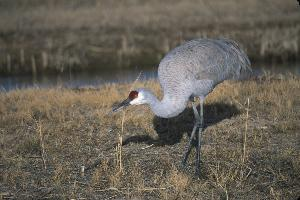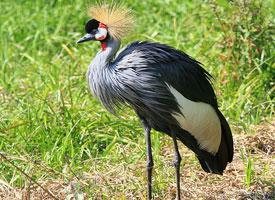
Description de l'animal
The Common Crane, scientifically known as Grus grus, is a majestic and elegant bird that belongs to the family Gruidae. This species is widely admired for its impressive size, distinctive call, and graceful aerial displays. Common Cranes are large birds, typically standing about 100 to 130 cm (3.3 to 4.3 ft) tall, with a wingspan ranging from 180 to 240 cm (5.9 to 7.9 ft). They weigh between 4 to 6 kg (8.8 to 13.2 lbs), with males generally being slightly larger than females.One of the most striking features of the Common Crane is its plumage. The body is primarily a slate-gray color, with a black-and-white streaked neck, and a striking black patch extending from the eyes to the upper neck. The tail feathers are black, and the wings are predominantly gray with white flight feathers visible when the wings are spread. Juveniles tend to have a more brownish coloration, which gradually turns into the adult's gray as they mature.
The Common Crane has a long, straight neck and long legs, adaptations that aid in their feeding habits. They are omnivorous birds, feeding on a wide variety of plant and animal matter, including seeds, roots, insects, small mammals, and amphibians. They are known to forage in wetlands, grasslands, and agricultural fields, often probing the soil with their long bills to extract food.
These birds are highly social and are often seen in large flocks, especially during migration. The Common Crane is known for its spectacular migratory behavior, with some populations traveling thousands of kilometers between their breeding and wintering grounds. They breed in northern parts of Europe and Asia, in wetlands and marshes where they build large nests on the ground. During winter, they migrate to southern Europe, Africa, and parts of Asia, where they congregate in large flocks in wetlands and agricultural fields.
The mating dance of the Common Crane is a sight to behold, involving a complex series of steps that include bowing, jumping, and wing-flapping. This ritual strengthens bonds between pairs and is also performed outside the breeding season as a social activity among the flock.
Despite facing threats from habitat loss and degradation, especially in their breeding areas, the Common Crane has managed to maintain stable population levels in many parts of its range, thanks in part to conservation efforts. They are protected under various international agreements and conservation programs aimed at preserving wetlands and other key habitats.
In folklore and mythology, the Common Crane is often associated with vigilance and loyalty, and its migratory patterns have made it a symbol of change and renewal. Its presence across diverse cultures underscores the universal appeal and fascination that these birds inspire.
Overall, the Common Crane is a remarkable bird, not only for its physical beauty and intriguing behaviors but also for its role in ecosystems and human culture. Its annual migrations are a reminder of the natural world's rhythms and the importance of global conservation efforts to ensure that future generations can continue to marvel at these magnificent birds.
Carte de répartition

Animaux similaires
Nouvelles photos d'animaux
Top 10 des animaux
- Dolphin gull (Leucophaeus scoresbii)
- Diana monkey (Cercopithecus diana)
- Moustached guenon (Cercopithecus cephus)
- Galápagos tortoise (Geochelone nigra complex)
- Russian tortoise (Testudo horsfieldii)
- Japanese macaque (Macaca fuscata)
- Stone loach (Barbatula barbatula)
- Greek tortoise (Testudo graeca)
- Common flying dragon (Draco volans)
- Colossal squid (Mesonychoteuthis hamiltoni)


